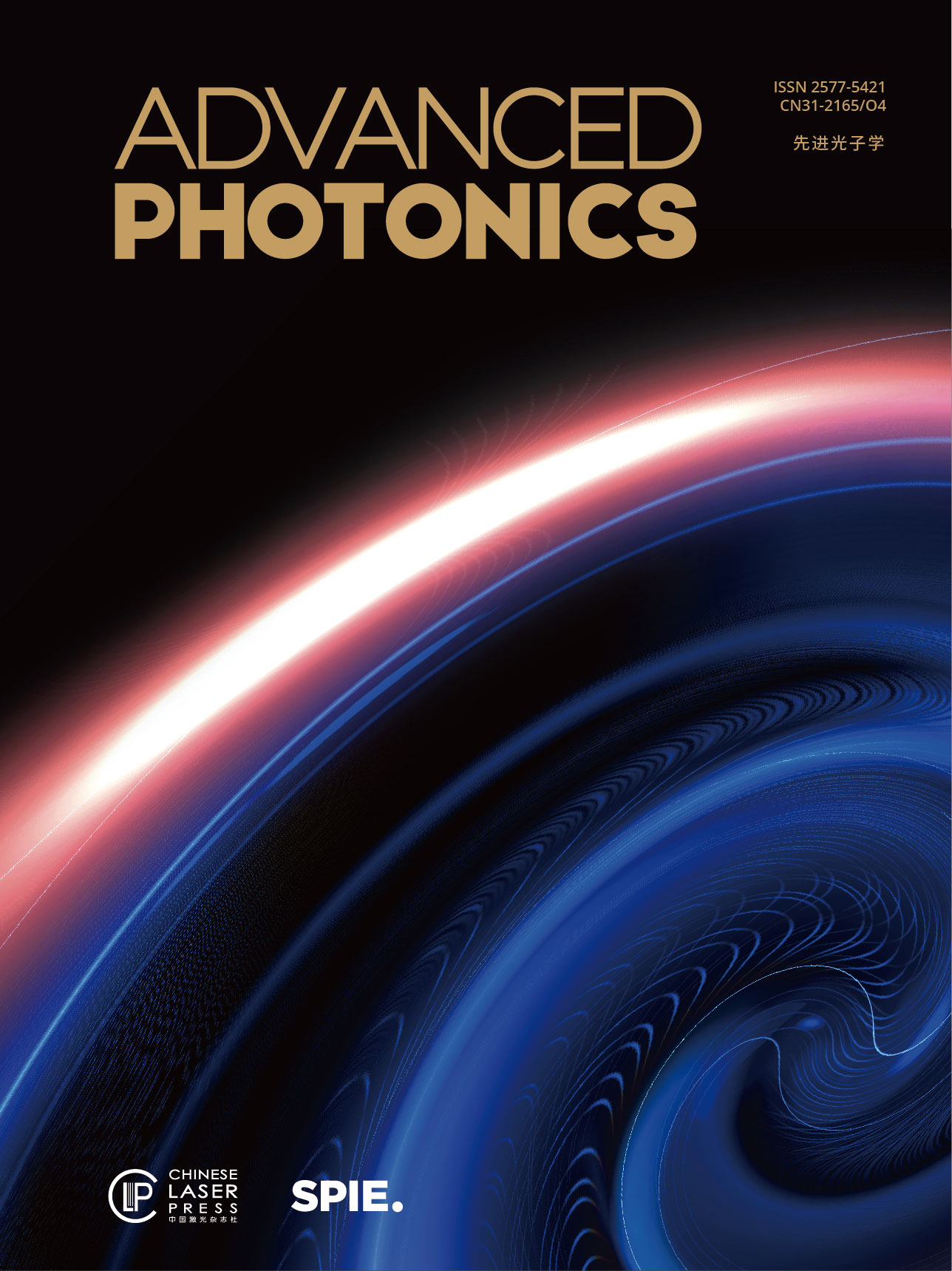Search by keywords or author
Contents
1 Issue (s), 2 Article (s)
Vol. 6, Iss.3—May.1, 2024 • pp: 035001-036001 Spec. pp:
Export citation format
Vol. 6, Iss.3-May..1,2024
Letters
Plasmon-assisted mode selection lasing in a lanthanide-based microcavityLei Guo, Min Ji, Bowen Kang, Min Zhang, Xin Xie, Zihao Wu, Huan Chen, Volker Deckert, and Zhenglong Zhang
Lanthanide-based microlasers have attracted considerable attention owing to their large anti-Stokes shifts, multiple emission bands, and narrow linewidths. Various applications of microlasers, such as optical communication, optical storage, and polarization imaging, require selecting the appropriate laser polarization mode and remote control of the laser properties. Here, we propose a unique plasmon-assisted method for the mode selection and remote control of microlasing using a lanthanide-based microcavity coupled with surface plasmon polaritons (SPPs) that propagate on a silver microplate. With this method, the transverse electrical (TE) mode of microlasers can be easily separated from the transverse magnetic (TM) mode. Because the SPPs excited on the silver microplate only support TM mode propagation, the reserved TE mode is resonance-enhanced in the microcavity and amplified by the local electromagnetic field. Meanwhile, lasing-mode splitting can be observed under the near-field excitation of SPPs due to the coherent coupling between the microcavity and mirror microcavity modes. Benefiting from the long-distance propagation characteristics of tens of micrometers of SPPs on a silver microplate, remote excitation and control of upconversion microlasing can also be realized. These plasmon-assisted polarization mode-optional and remote-controllable upconversion microlasers have promising prospects in on-chip optoelectronic devices, encrypted optical information transmission, and high-precision sensors.Lanthanide-based microlasers have attracted considerable attention owing to their large anti-Stokes shifts, multiple emission bands, and narrow linewidths. Various applications of microlasers, such as optical communication, optical storage, and polarization imaging, require selecting the appropriate laser polarization mode and remote control of the laser properties. Here, we propose a unique plasmon-assisted method for the mode selection and remote control of microlasing using a lanthanide-based microcavity coupled with surface plasmon polaritons (SPPs) that propagate on a silver microplate. With this method, the transverse electrical (TE) mode of microlasers can be easily separated from the transverse magnetic (TM) mode. Because the SPPs excited on the silver microplate only support TM mode propagation, the reserved TE mode is resonance-enhanced in the microcavity and amplified by the local electromagnetic field. Meanwhile, lasing-mode splitting can be observed under the near-field excitation of SPPs due to the coherent coupling between the microcavity and mirror microcavity modes. Benefiting from the long-distance propagation characteristics of tens of micrometers of SPPs on a silver microplate, remote excitation and control of upconversion microlasing can also be realized. These plasmon-assisted polarization mode-optional and remote-controllable upconversion microlasers have promising prospects in on-chip optoelectronic devices, encrypted optical information transmission, and high-precision sensors.
Advanced Photonics
- Publication Date: May. 08, 2024
- Vol. 6, Issue 3, 035001 (2024)
Research Articles
Hua Lu, Shouhao Shi, Dikun Li, Shuwen Bo, Jianxu Zhao, Dong Mao, and Jianlin Zhao
Optical cavities play crucial roles in enhanced light–matter interaction, light control, and optical communications, but their dimensions are limited by the material property and operating wavelength. Ultrathin planar cavities are urgently in demand for large-area and integrated optical devices. However, extremely reducing the planar cavity dimension is a critical challenge, especially at telecommunication wavelengths. Herein, we demonstrate a type of ultrathin cavities based on large-area grown Bi2Te3 topological insulator (TI) nanofilms, which present distinct optical resonance in the near-infrared region. The result shows that the Bi2Te3 TI material presents ultrahigh refractive indices of >6 at telecommunication wavelengths. The cavity thickness can approach 1/20 of the resonance wavelength, superior to those of planar cavities based on conventional Si and Ge high refractive index materials. Moreover, we observed an analog of the electromagnetically induced transparency (EIT) effect at telecommunication wavelengths by depositing the cavity on a photonic crystal. The EIT-like behavior is derived from the destructive interference coupling between the nanocavity resonance and Tamm plasmons. The spectral response depends on the nanocavity thickness, whose adjustment enables the generation of obvious Fano resonance. The experiments agree well with the simulations. This work will open a new door for ultrathin cavities and applications of TI materials in light control and devices.Optical cavities play crucial roles in enhanced light–matter interaction, light control, and optical communications, but their dimensions are limited by the material property and operating wavelength. Ultrathin planar cavities are urgently in demand for large-area and integrated optical devices. However, extremely reducing the planar cavity dimension is a critical challenge, especially at telecommunication wavelengths. Herein, we demonstrate a type of ultrathin cavities based on large-area grown Bi2Te3 topological insulator (TI) nanofilms, which present distinct optical resonance in the near-infrared region. The result shows that the Bi2Te3 TI material presents ultrahigh refractive indices of >6 at telecommunication wavelengths. The cavity thickness can approach 1/20 of the resonance wavelength, superior to those of planar cavities based on conventional Si and Ge high refractive index materials. Moreover, we observed an analog of the electromagnetically induced transparency (EIT) effect at telecommunication wavelengths by depositing the cavity on a photonic crystal. The EIT-like behavior is derived from the destructive interference coupling between the nanocavity resonance and Tamm plasmons. The spectral response depends on the nanocavity thickness, whose adjustment enables the generation of obvious Fano resonance. The experiments agree well with the simulations. This work will open a new door for ultrathin cavities and applications of TI materials in light control and devices.
Advanced Photonics
- Publication Date: Apr. 03, 2024
- Vol. 6, Issue 3, 036001 (2024)
Metasurface-based computational imaging: a reviewOn the Cover
Vol. 6, Issue 1, 014002 (2024)
Zwitterionic additive for high-performance pure-blue perovskite light-emitting diodes
Vol. 6, Issue 2, 020501 (2024)
Autonomous aeroamphibious invisibility cloak with stochastic-evolution learning
Vol. 6, Issue 1, 016001 (2024)
Metasurface-enabled augmented reality display: a review
Vol. 5, Issue 3, 034001 (2023)
Wide field-of-view metalens: a tutorial
Vol. 5, Issue 3, 033001 (2023)
Optical Orbital Angular Momentum: Thirty Years and Counting
Vol. 5, Issue 3, 030101 (2023)







